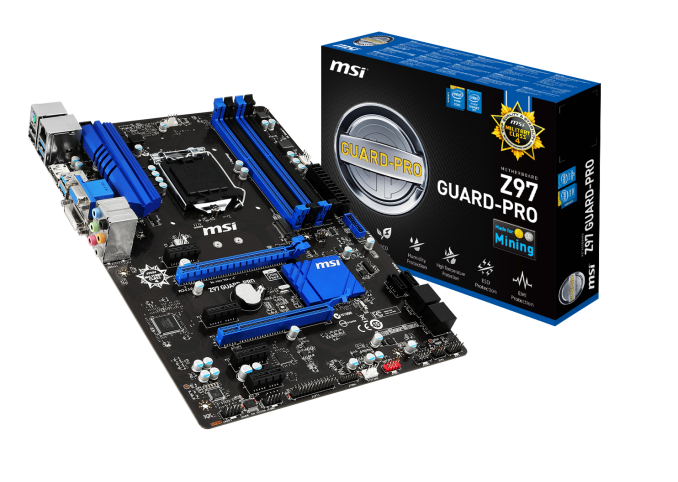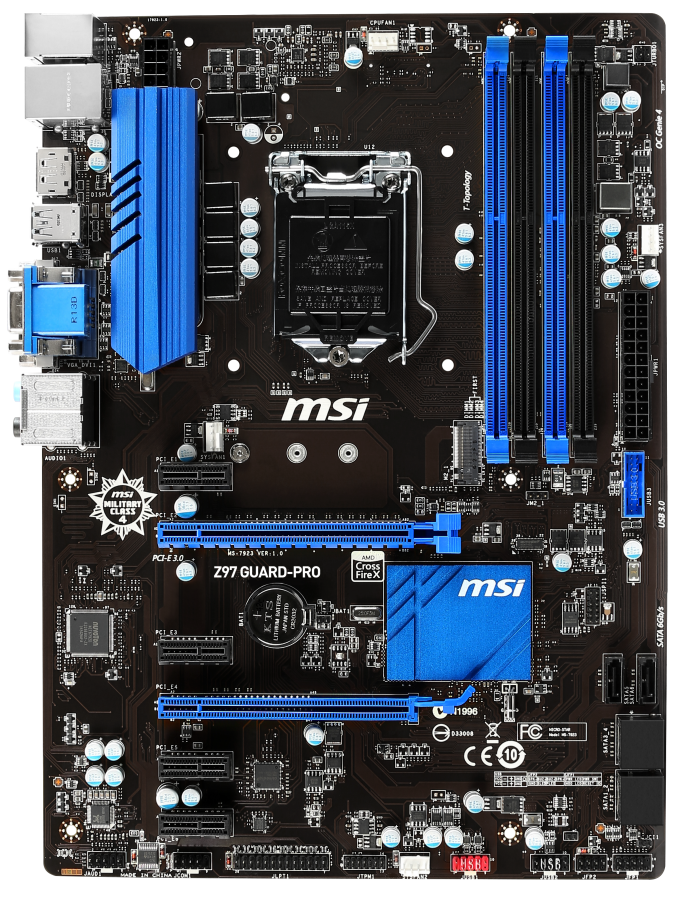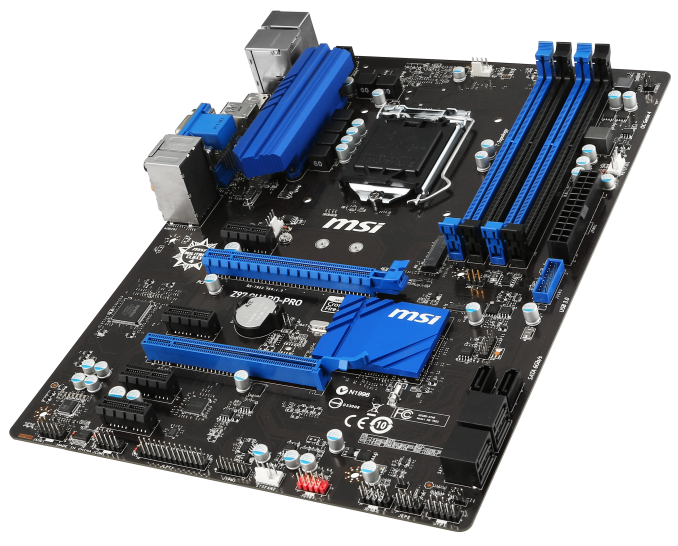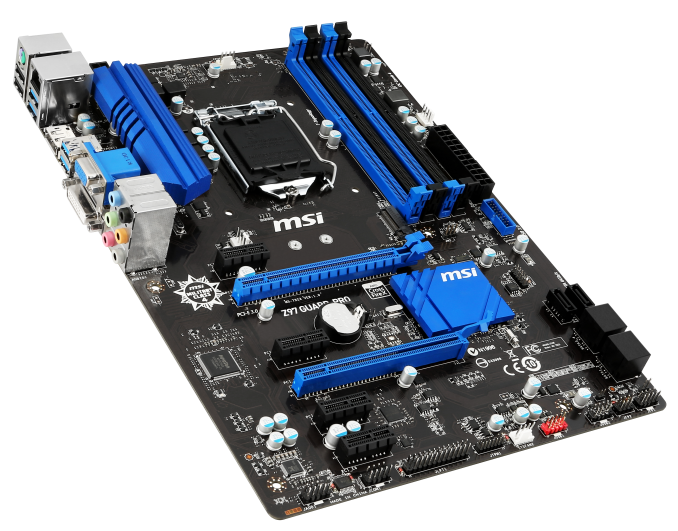MSI Z97 Guard-Pro Review: Entry Level Z97 at $110
by Ian Cutress on August 20, 2014 6:00 AM EST- Posted in
- Motherboards
- Intel
- MSI
- Z97

Next in our recent run of lower cost motherboards is the MSI Z97 Guard-Pro, a motherboard that MSI billed to me as one suited for the overclockable Pentium G3258 on a budget. At $110, we see if it differs much from the more expensive options on the market.
MSI Z97 Guard-Pro Overview
Having had the majority of my reviewing time at AnandTech dealing with motherboards equipped to the hilt, the Z97 Guard-Pro feels quite barren in contrast. The design looks lightweight, with only two full length PCIe slots, four power phases and six SATA ports. The traces on the motherboard between the components and slots also look fewer than the higher end models. Perhaps to reduce the price, this motherboard eschews SLI certification by only having one full PCIe 3.0 x16 from the CPU paired with a PCIe 2.0 x4 from the PCH.
One of the positive things to come from a cheaper end motherboard that still retains a high level chipset is the connectivity, meaning that the six SATA 6 Gbps ports is also paired with an M.2 x2 port and six USB 3.0 ports, one of which is a header. For most users this combination works out well, and the limited bandwidth on the second full length PCIe slot means that a couple of the SATA ports are coming out of the motherboard on the right hand side, which we normally see associated with a low cost product. Another feature for low cost is the combined use of Realtek ALC892 audio and a Realtek NIC which are often both bundled together at a lower than individual unit cost.
MSI is still equipping the board with its Military Class 4 designation, meaning that is passes various military standard tests, but the Guard-Pro element to the design is relatively new. The nomenclature is designed to encompass a series of design elements for increased protection, such as PCB coating for humidity protection (a paint rather than superhydrophobic), each IO port is fused for electrostatic discharge protection, the motherboard complies with FCC regulations for electromagnetic interference (though I would assume almost all motherboards would do) and also ECO Power implemented to allow for lower power operation.
We have covered MSI’s software and BIOS implementations for Z97 several times previously, and the ecosystem as a whole is a definite plus, giving an easy XMP button in the BIOS along with ordered overclock options and graphical fan controls. A couple of negative elements still exist however, such as high voltage selection in Control Center being very easily to implement and we experienced issues trying to get into the BIOS with too low a voltage selected during overclocking without a full BIOS reset.
Benchmark results across the board were in the bottom half compared to most of our other Z97 testing, and the ALC892 dynamic range audio results were lower than expected even for the codec used. DPC Latency was under a hundred which is a plus, with POST times around 12-13 seconds. USB performance was average, but power consumption figures were good for Z97: not ultimately surprising due to the lack of additional features here.
One of MSI’s points about the Z97 Guard-Pro when they shipped me the sample was their aim to make it one of their focus models for Pentium G3258 overclocking, and they provided an extra CPU sample for me to test with. That sample, despite some odd voltage jumps while ramping the frequency, hit 4.8 GHz without any issue with peak temperatures barely touching 80ºC. Despite the four power phases, the Z97 Guard-Pro can withstand a dual core overclocking session for a long-term build.
Visual Inspection
As mentioned above, my first look at this motherboard was one of surprise due to the lack of anything. Perhaps this is due to no power delivery heatsink above the socket and no white outline on the PCB showing where the socket should be. The four power phases for the CPU are to the left of the socket, with the heatsink covering the ICs that generate the heat. For a low cost motherboard, the heatsink is of a decent size which is good to see.
The motherboard has four 4-pin fan headers in white around the motherboard, three within the socket area. The CPU fan header is above the socket, and a 4-pin SYS fan header just above the first PCIe slot. Another SYS header is to the right of the DRAM slots, with the final header at the bottom of the motherboard. Having white fan headers does provide a contrast against the black PCB, although it does perhaps disjoint against the black and blue color of the rest of the motherboard, such as the DRAM slots, PCIe slots, heatsinks and USB 3.0 header.
On the right hand side of the motherboard is the USB 3.0 header, followed by two SATA 6 Gbps ports coming out of the board and four SATA 6 Gbps ports at 90º to the PCB. All six are from the PCH and have full RAID 0/1/5/10 capabilities. At the bottom of the board are the front panel headers, two USB 2.0 headers (the one in red supports fast charging), a TPM header, an LPT header, a COM header and the front audio header. In previous MSI motherboards I have leveraged a criticism that the front panel headers do not guide where the case connectors should be for power/reset buttons, but this motherboard has a printed on guide next to the SATA ports.
The PCIe slots are advertised as being ‘perfect for Bitcoin’, suggesting that all six can be used at once. This would mean that the four PCIe 2.0 x1 slots and PCIe 2.0 x4 slot are all available to use simultaneously, which would use up all eight of the chipset PCIe 2.0 lanes. As mentioned in the overview, this motherboard has a PCIe 3.0 x16/PCIe 2.0 x4 arrangement on the full length PCIe slots which means this motherboard does not support SLI with NVIDIA graphics cards. Crossfire is possible but the bandwidth restriction on that PCIe 2.0 x4 slot might not provide the maximum FPS gain desired by adding a second GPU.
The rear panel is slightly shifted compared to most other Z97 motherboards with the network port nearer the top of the motherboard and the D-Sub/DVI-D port lower down. Aside from these, the rear panel also houses a combination PS/2 port, two USB 2.0 ports, four USB 3.0 ports, a DisplayPort and the audio jacks. Having a DisplayPort on the motherboard rather than a HDMI seems odd, though it might save costs based on HDMI licensing.
Board Features
| MSI Z97 Guard-Pro | |
| Price | US (Newegg) |
| Size | ATX |
| CPU Interface | LGA-1150 |
| Chipset | Intel Z97 |
| Memory Slots |
Four DDR3 DIMM slots supporting up to 32 GB Up to Dual Channel, 1066-3300 MHz |
| Video Outputs |
DisplayPort (4096x2304 at 24 Hz, 3840x2160 at 60 Hz) VGA (1920x1200 at 60 Hz) DVI-D (1920x1200 at 60 Hz) |
| Onboard LAN | Realtek RTL8111G |
| Onboard Audio | Realtek ALC892 |
| Expansion Slots |
1 x PCIe 3.0 x16 1 x PCIe 2.0 x4 4 x PCIe 2.0 x1 |
| Onboard SATA/RAID | 6 x SATA 6 Gbps, RAID 0/1/5/10 |
| USB 3.0 | 6 x USB 3.0 [4 rear panel, one header] |
| Onboard |
6 x SATA 6 Gbps 1 x USB 3.0 Header 2 x USB 2.0 Headers 4 x Fan Headers 1 x TPM Header 1 x LPT Header 1 x COM Header Front Panel Headers Front Audio Header |
| Power Connectors |
1 x 24-pin ATX 1 x 4-pin CPU |
| Fan Headers |
1 x CPU 4-pin 3 x SYS 4-pin |
| IO Panel |
1 x Combination PS/2 Port 2 x USB 2.0 Ports 4 x USB 3.0 Ports VGA DVI-D DisplayPort 1 x Reatek NIC Audio Jacks |
| Warranty Period | 3 Years |
| Product Page | Link |
The Z97 Guard-Pro totally makes sense from the point of view of a compute platform that does not rely on PCIe bandwidth. MSI is promoting all of its protection features along with 6-way PCIe device supportand enough horsepower with an overclocked G3258 to organize the data. Note that the decision to use DVI-D, VGA and DisplayPort on the rear means that users can equip three screens from the processor graphics without issue.















41 Comments
View All Comments
Samus - Thursday, August 21, 2014 - link
Definitely agree about the Core 2's. Anything pre-Bloomfield is showing its age. But there is a subtle but noticeable difference between a Pentium Haswell and a Core i3 Haswell when using Windows 8/Office 2013, especially in Outlook and Access (programs that deal with large data files)Flunk - Wednesday, August 20, 2014 - link
I think it would match better with a i5 4670k, you're better off buying one of the few H-series boards that support overclocking the Pentium AE and saving the rest. If you're paying more for your board than your CPU you have a problem.Computer Bottleneck - Wednesday, August 20, 2014 - link
I'm glad Ian reviewed this board. It is very pertinent considering it is a board that has been bundled with Pentium G3258.Just less than a week ago the Pentium G3258 was on sale with the MSI Z97 Guard Pro for $110 AR ---> http://forums.anandtech.com/showthread.php?t=23954...
We don't find these kind of deals with the i3 or other Pentiums or Celerons.
Gigaplex - Wednesday, August 20, 2014 - link
It's a bit late to get into GPU bitcoin mining...Shadowmaster625 - Wednesday, August 20, 2014 - link
Ironically, I just got this board in last night, as part of a TD $100 G3258 combo. My G3258 will no go past 4.4GHz @ 1.299V. And the temps hit 92C under full load so upping the voltage isnt really an option. Even though these temps are high, I'm just going to leave it because during my suite of real world tests, the temps stayed below 70C.My main issue with the board is that my ethernet cuts out whenever I plug in any USB device. I have to unplug my LAN and then plug it back in or else it wont work. I tried plugging in a thumb drive as gently as I possibly could and it still caused the LAN to die.
Another annoying issue is that every time I move my SSD to a different SATA port, it makes the board think the overclocking failed, so I have to go back into the BIOS each time and turn it back on.
hojnikb - Wednesday, August 20, 2014 - link
Looks like a defected mobo, if you ask me.kwrzesien - Wednesday, August 20, 2014 - link
As far as the M.2 specs go, straight from the MSI manual:Intel Z97/ H97 Express Chipset
6x SATA 6Gb/s ports (SATA1~6)
1x M.2 port*
M.2 port supports M.2 SATA 6Gb/s module
M.2 port supports M.2 PCIe module up to 10Gb/s speed**
M.2 port supports 4.2cm/ 6cm/ 8cm length module
Supports RAID 0, RAID1, RAID 5 and RAID 10***
Supports Intel Smart Response Technology, Intel® Rapid Start
Technology and Intel Smart Connect Technology****
* The SATA5 and SATA6 ports will be unavailable when installing a module in the M.2 port.
** M.2 PCIe interface only supports UEFI option ROM, NOT support legacy option ROM.
*** M.2 PCIe interface does not support RAID 0, RAID1, RAID 5 and RAID 10.
**** Supports Intel Core processors on Windows 7 and Windows 8/ 8.1
So I don't see anything in the manual about the M.2 disabling any of the PCIe slots, either for SATA or PCIe type M.2 drives - it appears to use the SATA 5 & 6 ports either way. Anyway this is a PCIe 2.0 x2 10MB/s type connection, not x4 and not PCIe 3.0. Still would be very fast with the Plextor PCIe M.2 drives (which oddly cost less than the slower Micron SATA M2. drives): http://www.newegg.com/Product/Product.aspx?Item=N8... It appears that booting is supported natively.
anthill - Wednesday, August 20, 2014 - link
Anandtech should do an article discussing minimum fps. Looking at the bioshock numbers the difference between the best and worst motherboard is 13fps. Even the top board dips below the 30fps threshold that not even a g-sync monitor can help you with. BF4 isn't as significant but one still would be at a ~5fps disadvantage versus picking the top performing motherboards.Is this driver related? Can it be improved upon by opting for faster ram, 2133 vs 1600?
I feel it's a topic they could look into. Especially with VR coming soon I have read a gamer would need to hit a locked 90hz to feel a sense of "presence". These minimum fps benchmarks could become an issue going forward if one wants to hit the target fps needed.
StrangerGuy - Wednesday, August 20, 2014 - link
Why is anybody still running CPU performance benchmarks on mobo reviews in 2014 is beyond me. We would much rather see LPC latency, LAN/USB throughput, audio quality testing etc.lorribot - Wednesday, August 20, 2014 - link
Why is it always assumed that enthusiasts have unlimited funds? Most are probably like me, when it come to replacing the core of our system it is invariably on a restricted budget, not for us a $200 mobo and a $200 CPU. Anything that the mobo manufacturers can do to allow you to upsec the CPU to a K series is very welcome. I really don't care that it is Realtek as Intel will not really make that much difference over my poor adsl internet connection and I can't afford a speaker system that will show the difference between Realtek and Creative or anyone else's sound chips.All I want is a good strong, stable basic mobo that will allow overclocking for the minimum cost, this board gets close to this ideal.